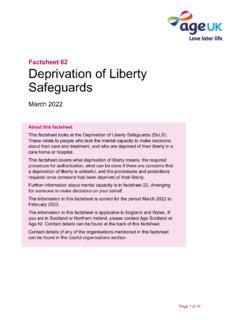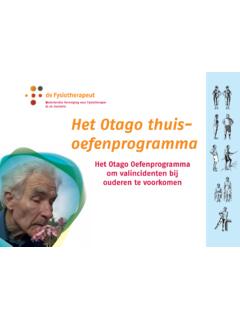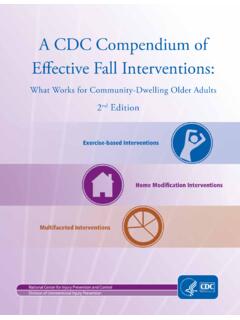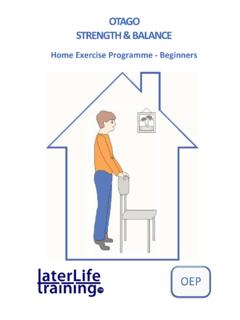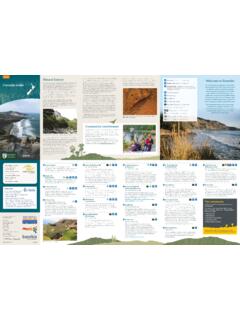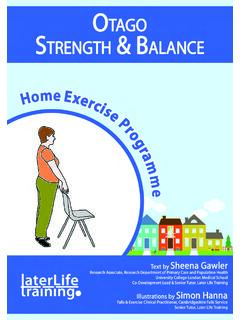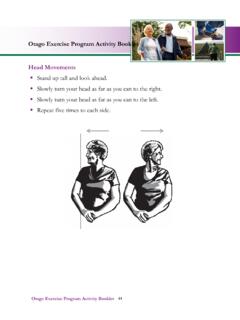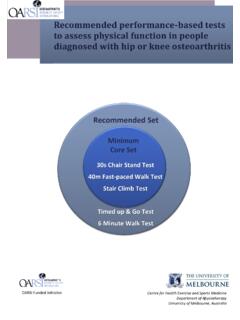Transcription of Falls Prevention Exercise – following the evidence - Age UK
1 Falls Prevention Exercise following the evidenceThe evidence for Falls Prevention Exercise and how it can be applied in seriesTo explain the research base for Falls Prevention Exercise to give a better understanding of the programmes that have been shown to be effective in preventing Commissioning Groups, Public Health professionals, commissioners of care services, health and care service providers, local Age UKs and other voluntary sector providers. Falls Prevention Exercise following the evidenceJune 2013 This document: Describes the evidence base for Falls Prevention Exercise Outlines the benefits of evidence -based Falls Prevention Exercise for older people and health and care services Presents a range of services delivering to the evidenceAmy Charters, Age UKCate Gillingwater, Philip Hurst and Katie Lau, Age UKCopies of this document can be obtained from thanks to the following organisations who advised and shared service examples.
2 Dr Dawn Skelton, Professor of Ageing and Health, Glasgow Caledonian University Age UK Oldham Cambridgeshire Community Services NHS Trust Age UK Doncaster Buckinghamshire Healthcare NHS Trust Age UK Cornwall & The Isles of ScillyDocument purposeTitleTarget audiencePublication dateContactAuthorWebAcknowledgementsDesc riptionResearchers and editorsContents 1 Why this guide? 4 Falls : the facts 42 Background 53 What is the evidence for Falls Prevention Exercise ? 7 Summary of evidence base for Falls Prevention Exercise 94 evidence based programmes 10 Examples of evidence based programmes 11 Falls Exercise pathway 12 Secondary Prevention programmes 135 evidence in practice 14 evidence in practice: service examples 156 Conclusion 207 Bibliography 21 Why this guide? Falls Prevention Exercise has been proven to be extremely effective in reducing Falls .
3 It plays an important role in the Falls care pathway, both in terms of primary and secondary Prevention , and can significantly contribute to reducing the financial burden on the NHS and social care by preventing fractures and avoidable hospital admissions. Audits of Falls and bone health services have consistently shown, however, that provision of Falls Prevention Exercise is patchy, at best, and often does not follow the guidelines for evidence -based guide explains the research behind Falls Prevention Exercise to give a better understanding of the kind of programmes that have been shown to be effective in preventing Falls . It also provides examples of evidence -based programmes that are currently in practice and demonstrates how they contribute to an integrated Falls care : the facts Falls and fractures in people aged 65 and over account for over 4 million hospital bed days each year in England The healthcare cost associated with fragility fractures is estimated at 2 billion a ye Injurious Falls , including 70,000 hip fractures annually, are the leading cause of accident-related mortality in older After a fall , an older person has a 50 per cent probability of having their mobility seriously impaired and a 10 per cent probability of dying within a Falls destroy confidence, increase isolation and reduce independence, with around 1 in 10 older people who fall becoming afraid to leave their homes in case they fall A tailored Exercise programme can reduce Falls by as much as 54 per Royal College of Physicians.
4 2011. Falling Standards, broken promises: report of the national audit of Falls and bone health in older people 20102 ibid3 ibid4 Help the Aged, 2008. Towards Common Ground5 Help the Aged, 2008. Spotlight Report 20084 Falls Prevention Exercise following the evidence June 2013 BackgroundThere are many different reasons why people fall in later life. It can happen as a result of dizziness caused by different medications6 or medical conditions, such as syncope or Parkinson s Disease. Falls can be caused by extrinsic factors such as poorly fitting footwear7 and uneven paving, or by the physiological conditions associated with ageing, such as natural deterioration in eyesight and muscle strength, which can make it difficult to balance,8 see and step over potential hazards. In many cases, it is not simply one, but a combination of these risk factors that leads to a detective work is therefore essential when it comes to determining the causes of, and effective treatment for a fall .
5 In addition to a multifactorial risk assessment, it is crucial that those at risk are offered a range of interventions, including medication reviews and home safety or hazard The most effective component of a multifactorial intervention is therapeutic Exercise ,11 as balance impairment and muscle weakness caused by ageing and disuse, are the most prevalent modifiable risk factors for 20 years of research into the subject has led to a very good understanding of exactly what kind of Exercise and how much is needed to be effective in preventing One Randomised Controlled Trial showed that a tailored group Exercise programme delivered over a nine month period can reduce the risk of falling by as much as 54 per Another, based in New Zealand and using home based Exercise over a year, showed a reduction of some 35 per Yet, despite this, and the huge potential these Exercise programmes hold in helping to make dramatic improvements in quality of life and achieve significant cost savings, older people continue to have limited access to evidence -based Falls Prevention programmes.
6 Where these programmes are available, the vast majority are altered or scaled down to an average duration of 12 weeks or Yet we know that a dose of at least 50 hours is necessary to reduce 6 NICE guidelines, CG161, 2013. Falls : The assessment and Prevention of Falls in older people7 Spink et al, 2011. Effectiveness of a multifaceted podiatry intervention to prevent Falls in community dwelling older people with disabling foot pain. British Medical Journal8 British Geriatrics Society and The College of Optometrists, 2010 The Importance of Vision in Preventing Falls9 Visibility, 2005. Deteriorating Vision, Falls and Older People: The links10 NICE guidelines, CG161, 2013. Falls : The assessment and Prevention of Falls in older people 11 Department of Health, 2009. Falls and fractures: effective interventions in health and social Cochrane Review, 2012.
7 Interventions for preventing Falls in older people living in the Skelton et al, 2005. Tailored group Exercise ( Falls Management Exercise FaME) reduces Falls in community-dwelling older frequent fallers (an RCT).14 Campbell at al, 1997. Randomised controlled trial of a general practice programme of home based Exercise to prevent Falls in elderly women. British Medical Journal15 Royal College of Physicians. 2011. National audit of Falls and bone health in older people16 Sherrington et al. 2011 Exercise to prevent Falls in older adults: an updated meta-analysis and best practice recommendations. New South Wales Public Health Bulletin5 Falls Prevention Exercise following the evidence June 2013 There are a number of reasons for this. Firstly, there are common misconceptions about what constitutes the evidence base for Falls Prevention Exercise perhaps because of the sheer number of research trials that have been undertaken.
8 Funding priorities can also be a barrier, particularly due to the duration of these programmes, which can appear expensive, even though the cost is low compared to the costs of fractures. However, much like prescribing half a dose of antibiotics (where the patient is unlikely to make a full recovery and need to return for further treatment), a half-course of Falls Prevention Exercise will be ineffective and result in even greater costs to health and social care services and may even increase the risk of Falls and addition, many instructors delivering Falls Prevention Exercise programmes are not appropriately trained,18 and therefore inadvertently promote alternative exercises as Falls Prevention (such as chair-based classes). This can reinforce misconceptions about what are a number of evidence based Exercise programmes, these are: otago FaME ( Falls Management Exercise )/Postural Stability Instructor (PSI)There is a need to ensure a smooth transition on from FaME/ otago programmes to further Exercise opportunities.
9 This will enable older people who have fallen to continue the progression of training to ensure effective Royal College of Physicians. 2012. Older people s experience of therapeutic Exercise as part of a Falls Prevention service. Patient and public involvement18 ibid 6 Falls Prevention Exercise following the evidence June 2013 What is the evidence for Falls Prevention Exercise ?3 What is the evidence for Falls Prevention Exercise ?The most important consideration when it comes to commissioning and delivering Falls Prevention Exercise is that there is no one-size fits all solution. Programmes must be tailored to the individual in order to be effective, which means the Exercise must be pitched at the right level and enable participants to progress. It must also take medical conditions and Falls history into account. So, whereas Tai Chi will be effective for those who have not yet fallen (or who have only mild deficits of strength or balance),19 it is less effective for those who have fallen and are more There is the potential that this could put those who have already experienced a fall at greater risk of falling again, if their balance is not good enough to safely perform three dimensional unsupported movement, or that it is adapted to seated or fully supported movement which will not reduce the risk of future summary, the evidence for effective Falls Prevention Exercise states that programmes must be of the correct type, duration and The principle of Falls Prevention Exercise is to counter the effects of muscle deterioration, particularly those that keep us upright and enable us to walk without swaying.
10 Therefore, all Falls Prevention Exercise must focus on strengthening leg and ankle muscles and challenging In essence, this means programmes must include resistance training and exercises done while standing. So, effective Falls Prevention cannot be achieved solely through chair-based programmes and seated gym it comes to the type of Exercise , it is also important to note that although programmes for both primary Prevention (preventing first Falls ) and secondary Prevention (preventing further Falls ) will be the same, ( both focus on strength and balance), they will vary in the way they are delivered in order to meet the needs of the individual, especially where there is higher risk of Falls . Programmes for secondary Prevention , for example, will need to provide more support in the form of targeted interventions with controlled movements, and in some cases, operate on a one-to-one Wolf et at.





